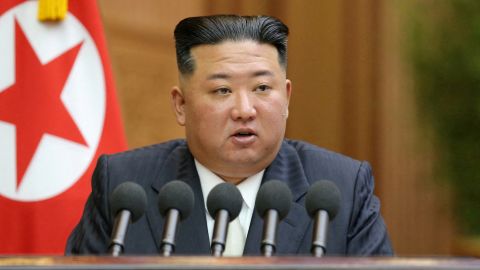Seoul, South Korea
CNN
—
North Korea South Korean officials said Wednesday that it fired at least 10 missiles east and west of the Korean peninsula, including one that landed close to South Korean waters for the first time since the 1945 split.
Seoul’s Joint Chiefs of Staff (JCS) said a short-range ballistic missile landed in international waters 167 kilometers (104 mi) northwest of South Korea’s Ulleung Island, about 26 kilometers south of the Northern Limit Line (NLL). North Korea does not recognize the Korean maritime border.
A South Korean defense official said the missiles fell into the Yellow Sea, known as the West Sea of Korea, to the west of the peninsula and the Sea of Japan, known as the East Sea, to the east.
Air raid warning Ulleung Island, located 120 kilometers east of the peninsula, was thrown up around 2pm local time on Wednesday. South Korean President Yoon Suk-yeol said the North Korean test was an “effective territorial encroachment”.
At an emergency National Security Council (NSC) meeting, Yoon “ordered a swift response to North Korea’s provocations to pay a clear price,” according to South Korea’s presidential office.
In immediate retaliation, South Korea fired three air-to-air missiles from F-15K and KF-16 fighter jets on Wednesday morning, according to the JCS.
The JCS said the South Korean Air Force targeted international waters north of the NLL, about the same distance that the missile landed south of the North Korean missile line.
“Our military’s precision strike demonstrates our willingness to respond decisively to any North Korean provocations, including a short-range ballistic missile, and our ability and readiness to precisely target the enemy,” the JCS said.
The JCS added that North Korea bears “full responsibility” for the situation as it continues to provoke despite warnings.
Wednesday’s launch was North Korea’s 29th this year, according to CNN.
The Aggressive Acceleration The weapons test has raised alarm in the region, with the US, South Korea and Japan retaliating with missile launches and joint military exercises.
On Monday, the United States and South Korea began a previously planned large-scale military exercise called “Vigilant Storm.”
The maneuvers involved 240 aircraft from both countries and “thousands of service members,” according to the US Department of Defense.
US Defense Secretary Lloyd Austin is scheduled to meet South Korean Prime Minister Lee Jong-sup at the Pentagon on Thursday.
Experts previously told CNN that North Korean leader Kim Jong Un’s deliberate display of the country’s arsenal could send a message at a time of heightened global conflict.
Last month, North Korean state media broke a six-month silence on missile tests this year, saying they would demonstrate Pyongyang’s readiness to fire tactical nuclear weapons at potential targets in the South.
The latest tests come after the head of the United Nations nuclear watchdog warned last week that Pyongyang may be preparing for a nuclear test — the first since 2017 — as satellite images showed activity at its underground nuclear test site.
“We are following this very, very closely. We hope it will not happen, but unfortunately the signs are going in the other direction,” International Atomic Energy Agency chief Rafael Croci said last Thursday.

Speaking on Wednesday, Japanese Prime Minister Fumio Kishida told reporters that North Korea was launching missiles with “unprecedented frequency.”
Kishida also called for an early meeting of the National Security Council due to rising tensions on the Korean Peninsula.
Earlier on Wednesday, Japanese Defense Minister Yaukazu Hamada said North Korea had fired at least two missiles and both were estimated to have fallen outside Japan’s Exclusive Economic Zone (EEZ).
He said there was no damage to aircraft or ships at the time, adding that the ballistic missiles may have flown on an erratic trajectory.

“Friend of animals everywhere. Devoted analyst. Total alcohol scholar. Infuriatingly humble food trailblazer.”